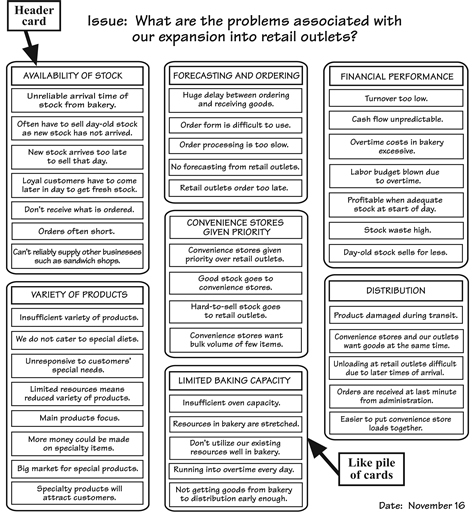What is it?
An affinity diagram is the organized output from a brainstorming session. It is one of the seven management tools for planning. The diagram was created in the 1960s by Kawakita Jiro and is also known as the KJ method.
The purpose of an affinity diagram is to generate, organize, and consolidate information concerning a product, process, complex issue, or problem. Constructing an affinity diagram is a creative process that expresses ideas without quantifying them.
The affinity diagram helps a group to develop its own system of thought about a complex issue or problem. A group can use an affinity diagram at any stage where it needs to generate and organize a large amount of information. For example, members of a leadership team may use the diagram during strategic planning to organize their thoughts and ideas. Alternatively an improvement team can use the diagram to analyze the common causes of variation in its project. The diagram is flexible in its application and is easy to use.
What does it look like?
A completed affinity diagram is shown below. In the example, a bakery has recently expanded its business and opened a chain of retail outlets. A number of problems have arisen and the management team, involved with the retail outlets, has met to discuss the problems. The issues are complex so they have decided to complete an affinity diagram.

When is it used?
Use an affinity diagram when you can answer “yes” to all of the following questions:
- Is the problem (or issue) complex and hard to understand?
If the problem or issue is relatively simple or easy to understand, a cause-and-effect diagram may be more appropriate.
- Is the problem uncertain, disorganized, or overwhelming?
Complex issues often feel overwhelming due to their size.
- Does the problem require the involvement and support of a group?
The process a group goes through to make an affinity diagram helps the group develop its own system of thought concerning the problem and builds consensus among the members.
Getting the most
- Choose a facilitator.
The facilitator is responsible for leading the group through the steps to make the affinity diagram. It is beneficial to have a facilitator experienced in making affinity diagrams.
- State the issue or problem.
Before beginning, the group should state the issue or problem to be addressed. It is often useful to state the problem in the form of a question. In the example, the question is, “What are the problems associated with our expansion into retail outlets?” It is essential that the group understands the aim of the session.
- Brainstorm and record ideas.
Next, brainstorm ideas concerning the issue statement. Brainstorming for ideas to make an affinity diagram uses a mixture of traditional brainstorming and the Crawford slip method. In traditional brainstorming, individuals generate ideas, which they voice in turn. Ideas are given by each person in the group until no one has anything else to add. In the Crawford slip method, ideas are recorded on index cards, slips of paper, or sticky notes, in silence. There is no verbal exchange. Brainstorming for the affinity diagram uses a mixture of these two approaches.
The above article is an excerpt from the “Operational Definition” chapter of Practical Tools for Continuous Improvement Volume 2 Statistical Tools.